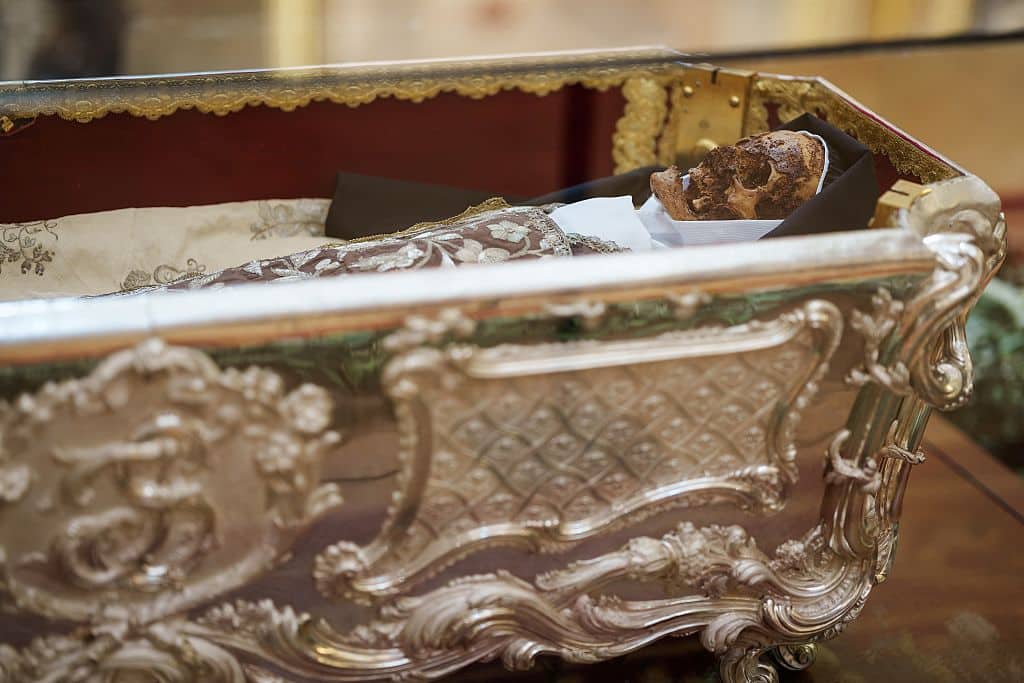The first public display in more than a century of the corpse of Spain’s beloved saint who died 440 years ago has split opinion, with some inspired and deeply moved, while others see it as macabre voyeurism.
The body of Saint Teresa of Avila is on public display for the first time since 1914. Nearly 70,000 people have travelled from across Spain and as far away as Ascension Island to see St Teresa, <mark style="background-color:rgba(0, 0, 0, 0)" class="has-inline-color has-vivid-cyan-blue-color"><a href="https://www.thetimes.com/article/31e84550-0d8b-4337-b4d3-95d55d1d6944">reports</a> </mark><em>The Times</em> of London. For the past two weeks, the saint’s corpse, with the skull resting above the habit of her order and reposed in an open silver coffin, has been exhibited in the Basilica of the Annunciation of Our Lady of Mount Carmel in Alba de Tormes, in northwestern Spain.
“A mild air of religious euphoria hangs over the town, which is surrounded by a vast meseta landscape of poppy-fringed pasture in the western Salamanca province,” writes Isambard Wilkinson in her "Letter from Spain" for <em>The Times</em>.
She notes that St Teresa of Avila has been revered by people ranging from the fashion designer Manolo Blahnik to Spain's dictator, Francisco Franco, who kept a relic of her hand next to his bed, and that the saint "was a pillar of Spain’s 16th-century Counter-Reformation and embodies the passion of Spain’s old faith".
Somerset Maugham called <em>The Life of Teresa of Jesus</em> “one of the great autobiographies of the world”. The psychological explorations of Teresa, who famously wrote of her mortifications and spiritual ecstasies, were likened by the British hispanist Gerald Brenan to those of Montaigne, Wilkinson notes.
“It’s historic as she has only been viewed by the public twice before since her death in 1582 and this is the longest she has ever been on show,” says Miguel Ángel González, the prior of the the Discalced Carmelites of Salamanca who are responsible for looking after the saint's remains, as he admired the queue of pilgrims that snaked down the street. “People come to receive St Teresa’s blessing.”
Near the coffin stand glass cases on permanent display containing a handless arm and a shrivelled human heart. “You can see the marks on her arm where slices have been cut for relics,” says the prior. “The phial for her heart is open because when they put it in a closed one it burst the glass, which is extraordinary.”
Wilkinson observes a couple who, having reached the front of the queue, hold hands and pray, while another woman silently weeps and smiles.
Among the pilgrims filing out of the church, Maria Jesus Bartolome, a pensioner from Galicia, says: “I was so emotional I had to put on my sunglasses to hide my tears.”
Another, Roman Pinero, 66, from Toledo, comments: “On seeing the body of Santa Teresa one recalls that we all live and die, even if you are the queen of England.”
The fervour, Wilkonson says, serves as a reminder of how, despite decades of secularisation in Spain, the Catholic Faith "still holds a grip on many hearts and that the Church still enjoys a privileged status".
But not everyone approves of the prior’s initiative to display the remains of the great Spanish doctor of the Church.
“It is not a good idea to display the body of Saint Teresa in this way,” José Luis Retana, the Bishop of Salamanca, has publicly declared. “It only serves to encourage people’s morbid curiosity.”
A retired teacher from Asturias who has come to see the saint, says: “I am not drawn here by a religious fervour for her – she was perhaps anorexic and had hallucinations. My regard for Santa Teresa is because she was one of Spain’s great literary figures.” He adds: “Also, I confess to being here due to a certain morbid fascination.”
His wife then says: “There is no miracle about the preservation of the remains, some bodies are preserved better than others, like a cured leg of ham.”
Mother Elsa, the prioress, says: “Logically, like everything else, there are people who are in favour and people against it, especially people who perhaps do not have that devotion to the saint, or, well, who think that this may even be macabre.”
Earlier this year, the prior commissioned a special scientific study of St Teresa's remains, which investigated the illnesses that the saint suffered from and the unusual physical aspects of her corpse.
It follows the discovery last year, when the tomb was opened on 28 August in order to facilitate further studies, that the remains of St Teresa were in the same condition as they were when last inspected in 1914 – incorrupt.
“The grace of God has sanctified her body and that’s why her relics are venerated and can produce miracles,” said the prior. “St Teresa in her day stoked passions and nearly 500 years later she continues to do so.”
St Teresa died in 1582 and due to her growing fame and sainthood, some of her remains were dispersed around Europe as holy relics. But the rest of her body, including her heart and arm, remain kept under careful vigilance in Alba de Tormes.
So much so that, reportedly, to open the urn containing her body, 10 separate keys are needed; three of which are kept in Rome.
“She’s <em>muy chiquitita</em> [very small], the <em>señora</em>,” said one woman after seeing the coffin.
<a href="https://thecatholicherald.com/st-teresa-of-avilas-remains-still-incorrupt-after-tomb-opened-for-further-studies/"><mark style="background-color:rgba(0, 0, 0, 0)" class="has-inline-color has-vivid-cyan-blue-color"><strong><em>RELATED: St Teresa of Ávila’s remains still incorrupt after tomb opened for studies</em></strong></mark></a>
<em>Photo: 1827 portrait of St Teresa (Wikimedia Commons)</em>



